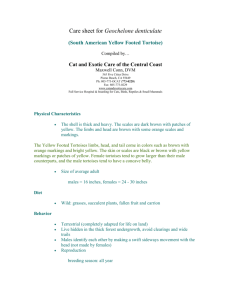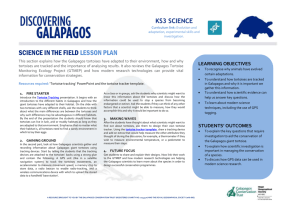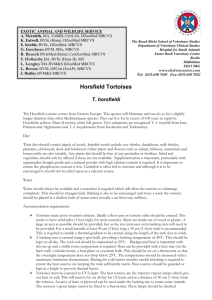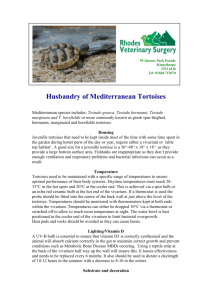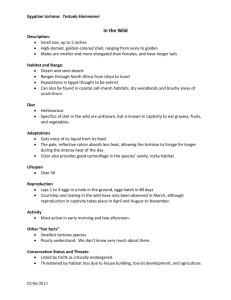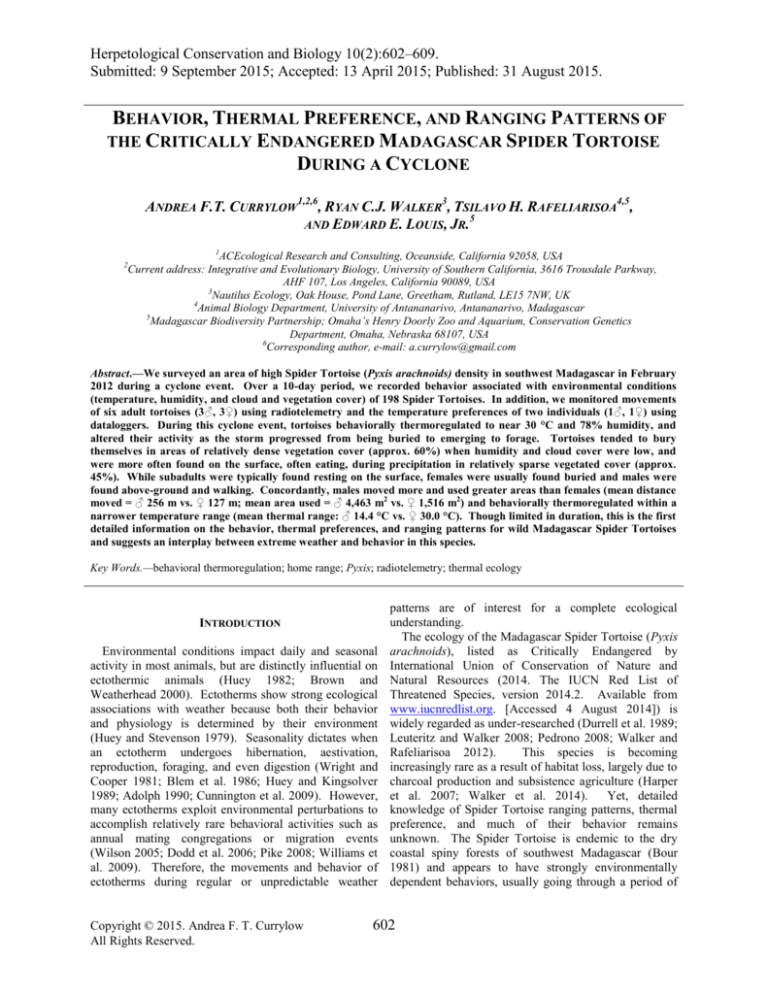
Herpetological Conservation and Biology 10(2):602–609.
Submitted: 9 September 2015; Accepted: 13 April 2015; Published: 31 August 2015.
BEHAVIOR, THERMAL PREFERENCE, AND RANGING PATTERNS OF
THE CRITICALLY ENDANGERED MADAGASCAR SPIDER TORTOISE
DURING A CYCLONE
ANDREA F.T. CURRYLOW1,2,6, RYAN C.J. WALKER3, TSILAVO H. RAFELIARISOA4,5,
5
AND EDWARD E. LOUIS, JR.
1
ACEcological Research and Consulting, Oceanside, California 92058, USA
Current address: Integrative and Evolutionary Biology, University of Southern California, 3616 Trousdale Parkway,
AHF 107, Los Angeles, California 90089, USA
3
Nautilus Ecology, Oak House, Pond Lane, Greetham, Rutland, LE15 7NW, UK
4
Animal Biology Department, University of Antananarivo, Antananarivo, Madagascar
5
Madagascar Biodiversity Partnership; Omaha’s Henry Doorly Zoo and Aquarium, Conservation Genetics
Department, Omaha, Nebraska 68107, USA
6
Corresponding author, e-mail: a.currylow@gmail.com
2
Abstract.—We surveyed an area of high Spider Tortoise (Pyxis arachnoids) density in southwest Madagascar in February
2012 during a cyclone event. Over a 10-day period, we recorded behavior associated with environmental conditions
(temperature, humidity, and cloud and vegetation cover) of 198 Spider Tortoises. In addition, we monitored movements
of six adult tortoises (3♂, 3♀) using radiotelemetry and the temperature preferences of two individuals (1♂, 1♀) using
dataloggers. During this cyclone event, tortoises behaviorally thermoregulated to near 30 °C and 78% humidity, and
altered their activity as the storm progressed from being buried to emerging to forage. Tortoises tended to bury
themselves in areas of relatively dense vegetation cover (approx. 60%) when humidity and cloud cover were low, and
were more often found on the surface, often eating, during precipitation in relatively sparse vegetated cover (approx.
45%). While subadults were typically found resting on the surface, females were usually found buried and males were
found above-ground and walking. Concordantly, males moved more and used greater areas than females (mean distance
moved = ♂ 256 m vs. ♀ 127 m; mean area used = ♂ 4,463 m2 vs. ♀ 1,516 m2) and behaviorally thermoregulated within a
narrower temperature range (mean thermal range: ♂ 14.4 °C vs. ♀ 30.0 °C). Though limited in duration, this is the first
detailed information on the behavior, thermal preferences, and ranging patterns for wild Madagascar Spider Tortoises
and suggests an interplay between extreme weather and behavior in this species.
Key Words.—behavioral thermoregulation; home range; Pyxis; radiotelemetry; thermal ecology
INTRODUCTION
Environmental conditions impact daily and seasonal
activity in most animals, but are distinctly influential on
ectothermic animals (Huey 1982; Brown and
Weatherhead 2000). Ectotherms show strong ecological
associations with weather because both their behavior
and physiology is determined by their environment
(Huey and Stevenson 1979). Seasonality dictates when
an ectotherm undergoes hibernation, aestivation,
reproduction, foraging, and even digestion (Wright and
Cooper 1981; Blem et al. 1986; Huey and Kingsolver
1989; Adolph 1990; Cunnington et al. 2009). However,
many ectotherms exploit environmental perturbations to
accomplish relatively rare behavioral activities such as
annual mating congregations or migration events
(Wilson 2005; Dodd et al. 2006; Pike 2008; Williams et
al. 2009). Therefore, the movements and behavior of
ectotherms during regular or unpredictable weather
Copyright © 2015. Andrea F. T. Currylow
All Rights Reserved.
patterns are of interest for a complete ecological
understanding.
The ecology of the Madagascar Spider Tortoise (Pyxis
arachnoids), listed as Critically Endangered by
International Union of Conservation of Nature and
Natural Resources (2014. The IUCN Red List of
Threatened Species, version 2014.2. Available from
www.iucnredlist.org. [Accessed 4 August 2014]) is
widely regarded as under-researched (Durrell et al. 1989;
Leuteritz and Walker 2008; Pedrono 2008; Walker and
Rafeliarisoa 2012).
This species is becoming
increasingly rare as a result of habitat loss, largely due to
charcoal production and subsistence agriculture (Harper
et al. 2007; Walker et al. 2014).
Yet, detailed
knowledge of Spider Tortoise ranging patterns, thermal
preference, and much of their behavior remains
unknown. The Spider Tortoise is endemic to the dry
coastal spiny forests of southwest Madagascar (Bour
1981) and appears to have strongly environmentally
dependent behaviors, usually going through a period of
602
Currylow et al.—Spider Tortoise activity during a cyclone.
aestivation during the dry season from April to October
(Pedrono 2008; Walker et al. 2008; Currylow 2012).
The species is one of the smallest tortoise species in the
world at approximately 11 cm straight-line carapace
length (SCL), and based on this, it has been presumed
that Spider Tortoises exhibit low dispersal behavior and
maintain relatively small home ranges (Walker 2010,
2012).
However, there is speculation that heavy
precipitation can increase Spider Tortoises activity levels
(Pedrono 2008), suggesting that tortoises may require
more ranging habitat area than previously expected. To
conserve or restore appropriate Spider Tortoise habitat,
more detailed information on their ecology, including
ranging requirements, weather-related activities, and
thermal preferences are needed. We undertook a brief
and opportunistic field study to investigate the behavior
of a sub-species of Spider Tortoises (P. a. arachnoides)
within the center of the range of the species in
southwestern Madagascar. During a single cyclonic
event while conducting a broader study at our field site
(Walker et al. 2014), we aimed to: (1) characterize
Spider Tortoise activity with relation to sex, age class,
microhabitat variables, and weather; (2) determine
thermoregulatory preferences; and (3) obtain preliminary
movement data for the species.
METHODS
Study site.—We studied tortoise in a 10.2 km2 patch
of southern dry forest habitat near Toliara, in
southwestern Madagascar. The area comprises patchy
xerophytic scrub (Fenn 2003) and supports one of the
densest populations of P. a. arachnoides within the
range of the species (Walker et al. 2008). Historically,
the forest scrub was dominated by species in the families
of Euphorbiaceae and Didiereaceae, but much of the
habitat of the region has been severely altered over the
past 40 y due predominately to fuel wood harvest for
charcoal production and livestock grazing (Jesu and
Schimmenti 1995; Harper et al. 2007; Walker et al.
2012a). Annual rainfall in the habitat peaks at around
350 mm and is concentrated in the period from
December to March (Durrell et al. 1989; Jesu and
Schimmenti 1995).
Cyclone description.—Our study overlapped with
Intense Tropical Cyclone Giovanna (9–21 February
2012). On 14 February 2012, Giovanna made landfall
on the east side of Madagascar and traversed the island
to the Mozambique Channel before beginning a wide uturn around the southwestern coast, encompassing our
study area. The Toliara weather station near our study
site reported a local average rainfall of 18.7 mm in 24 h.
On 18 February, Giovanna moved eastwards alongside
the southern tip of Madagascar, began to weaken to a
tropical depression on 20 February, and dissipated late
on 21 February. We used storm path and site-proximity
data to break up survey dates into three “storm
timeframes” for analysis: (1) early-storm = 11–13; (2)
mid-storm = 14–16; and (3) late-storm = 17–20
February. We continually monitored storm temperature
and humidity at the survey site using a HygrochronTM
iButton temperature and humidity datalogger (model
DS1923-F5#, Maxim Integrated Products, Inc.,
Sunnyvale, California, USA) beginning 12 February
2012. This logger was set to record temperature and
humidity every hour and was affixed low on vegetation
to collect the ground microclimate comparable to that
which tortoises experience.
Species monitoring.—From 11 February through 20
February 2012, we located Spider Tortoises by
systematic meandering line-transects within 1-ha plots
(following Walker et al. 2008). Each time an animal
was encountered, we recorded its age/sex class (male,
female, or unsexable sub-adult) and behavior. We
grouped behaviors into six Activity Class categories that
best matched the observation including: buried (found
buried in leaf litter or soil), resting (resting on the soil
surface in open), in vegetation (resting in or under
vegetation), eating, digging, or walking. We used a
Kestrel® 3000 pocket weather meter (Nielsen-Kellerman,
Boothwyn, Pennsylvania, USA) to record ground
temperatures (°C) and humidity (%) at the tortoise
location. We also recorded the presence or absence of
precipitation and obtained visual estimates of vegetation
and cloud cover (in 10% intervals following Walker et
al. 2012b).
We selected six adults (three ♂ and three ♀) to be
repeatedly relocated every 1–3 d. A radio transmitter
(RI-2C, Holohil Systems, Ltd., Carp, Ontario, Canada)
was epoxied to the carapace and was ≤ 5% of the total
body weight of the tortoise. We then located radiotelemetered animals four more times (totaling five
locations each) through the duration of the cyclone. We
were careful to minimize disturbance of the tortoises
during relocations, and recorded each activity class and
associated microclimatic conditions. We also chose two
of the radio-telemetered individuals (one of each sex) to
carry a Thermochron® iButton temperature datalogger
(model DS1921G-F5#, Maxim Integrated Products, Inc.,
Sunnyvale, California, USA). The iButtons continually
recorded the preferred temperatures of those two animals
every three hours.
Analyses.—We tested assumptions of normality and
equal variances of the data (e.g., behavior by date,
presence of precipitation, storm timeframe, and age/sex
class, and environmental data) and used t-tests to
compare temperatures and humidities recorded at
tortoise locations against ambient.
For the nonparametric analyses, we used Chi-square analyses
603
Herpetological Conservation and Biology
FIGURE 1. Percentages of observed behaviors (activity classes) by age/sex class (male, female, or sub-adult) of Spider Tortoises (Pyxis a.
arachnoides) in southwestern Madagascar over the course of a cyclone (early-storm = 11–13, mid-storm = 14–16, and late-storm = 17–20
February 2012). Percentages represent the proportion of the observed behavior within the class.
followed by correspondence analyses or generalized
linear mixed models (GLMMs). For the GLMMs, we
used individual ID as the random subject effect to avoid
pseudoreplication (e.g., repeated measures of tracked
animals or data from dataloggers). Where GLMMs
yielded significant results, we followed with Tukey’s
HSD post-hoc analyses to determine the specific
significant effects of the model. We used JMP® Pro
11.0.0 software (SAS Institute Inc., Cary, North
Carolina, USA) to run all statistical analyses.
Significance was determined at P ≤ 0.05. For radiotelemetered tortoises, we used ArcGIS 10.2 software
(ESRI, Redlands, California, USA) to calculate distances
and total areas used (minimum convex polygons) by
each animal. We report only summary statistics (means
and ranges) on the ranging patterns due to the limited
duration of the study and resulting restricted dataset.
RESULTS
During surveys 11–20 February 2012, we found 198
Spider Tortoises (57♂, 81♀, 60 sub-adult). We relocated
(radio-tracked) six of those tortoises (three ♂, three ♀)
every 1–3 d for four more observations each (222
tortoise data points total). The HygrochronTM, which
measured environmental variables hourly, logged 202
temperature and 202 humidity readings. The two
iButton temperature loggers deployed on tortoises (1♂,
1♀) profiled an additional 283 tortoise-temperature data
points over the course of this study.
Activity.—We collected behavior data representing
219 tortoise observations (68 ♂, 91 ♀, 60 sub-adult) of
the total 222 tortoise observations in this study as three
activity class observations were not recorded. We found
only one animal digging, so it was left out of the
analyses; however, we included this data point in the
figure for reference. Participation in activity classes
differed significantly (χ2 = 24.11, df = 6, P < 0.001).
Aside from resting most of the time (53% of all
observations), tortoises were often found buried earlystorm (28% of observations), and then were often found
walking and eating as the storm progressed (22% and
15% of observations respectively). We also found a
significant differences in behavior between the sexes and
subadults (χ2 = 12.81, df = 6, P = 0.046; Fig. 1).
There was a significant difference in the percentage of
Spider Tortoise activities depending on presence or
absence of precipitation. During rain, tortoises were
more often found resting or eating, whereas they would
more often be found walking or buried below soil when
there was no rain (χ2 = 8.99, df = 3, P = 0.029). We also
found significant differences in behavior associated with
604
Currylow et al.—Spider Tortoise activity during a cyclone.
TABLE 1. Daily mean carapacial temperatures recorded using iButton temperature loggers affixed to the carapace of a single male and single
female Spider Tortoise (Pyxis a. arachnoides) during a cyclone in southwestern Madagascar. Temperatures were recorded every three hours
from 12–20 February 2012.
Date
n
♂ Mean Temp
(Min–Max)
SD
♀ Mean Temp
(Min–Max)
SD
♂
12-Feb.
27
27.5 (22.0–34.0)
4.4
27.3 (21.5–43.5)
7.7
12.0
22.0
33.0
Thermal Range
♀
13-Feb.
32
29.2 (23.0–37.5)
4.7
34.3 (23.0–56.0)
11.3
14.5
14-Feb.
32
27.6 (21.5–33.5)
4.2
33.0 (22.0–51.5)
10.4
12.0
29.5
15-Feb.
32
26.9 (20.5–37.0)
5.1
31.8 (20.5–54.5)
11.3
16.5
34.0
16-Feb.
32
27.6 (19.0–39.0)
6.8
32.8 (19.5–59.0)
13.1
20.0
39.5
31.5
17-Feb.
32
28.0 (22.5–34.5)
4.1
33.6 (22.5–54.0)
11.4
12.0
18-Feb.
32
29.8 (25.5–37.0)
4.0
34.1 (26.0–54.5)
10.1
11.5
28.5
19-Feb.
32
25.8 (19–33.0)
5.0
26.5 (18.0–42.0)
7.2
14.0
24.0
20-Feb.
32
22.2 (14.0–31.0)
6.0
25.0 (14.0–42.0)
10.0
17.0
28.0
27.2 (20.8-35.2)
4.9
30.9 (20.8-50.8)
10.3
14.4
30.0
Mean
variations in humidity, vegetation cover, and cloud cover
(F5,37 = 7.80, P < 0.001). Tortoises were often found
eating or resting above ground when humidity was
elevated (82.1–83.8%, SE = 1.5–3.7) as opposed to
being found buried or in vegetation when humidity was
lower (66.0–71.6%, SE = 1.9–4.5). The mean percent of
vegetation cover (61.4% SE = 2.6) was significantly
higher in areas where tortoises were found buried and
was lower (45.1% mean vegetation cover, SE = 3.1)
where they were found walking (F5,123 = 4.80, P =
0.001). When the mean cloud cover was low (38.4%,
SE = 3.2), tortoises were often found buried, but when
mean cloud cover was high (73.0%, SE = 9.8), the
tortoises were more likely to be found significantly more
often eating (F4,6 = 6.08, P = 0.022).
Weather and temperature preferences.—Over the
course of the storm, the HygrochronTM environmental
datalogger recorded temperatures ranging from 20.6–
45.0 °C and humidity from 23.8–100%. When limited to
temperatures and humidities recorded only within an
hour of tortoise encounters (i.e., excluding those times
not comparable to tortoise behavior observations), the
averages were 26.4 °C (20.6–34.6 °C, SE = 0.4) and
82.2% (40.9–99.2%, SE = 2.1). Those environmental
readings were significantly different from tortoiselocation ground temperatures (mean = 30.4 °C [24.5–
37.3 °C], SE = 0.2; t = 9.50, df = 258, P < 0.001).
However, tortoise-location humidities were not distinct
from the environmental humidity readings (mean =
79.6% [40.6–100%], SE = 1.2; t = ˗1.07, df = 257, P =
0.284), but raw data were bimodal in distribution,
concentrating at upper and lower quartiles of 94.2% and
64.3 %.
The mean tortoise-location temperatures began
significantly higher averaging 33.3 °C (SE = 0.4) earlystorm, then dipped mid-storm and late-storm (to 28.8 °C,
SE = 0.3 and 29.8 °C, SE = 0.3 respectively; F2,2 =
42.80, P < 0.001). Humidities recorded at tortoise
locations were also significantly different (F2,2 = 51.89,
P < 0.001), beginning low at 63.4% (SE = 2.0) earlystorm, rising to 81.5% (SE = 1.6) mid-storm, and
continuing to rise to 89.3% (SE = 1.5) late-storm.
We found no significant differences between classes
in the preferred ground temperatures (F2,2 = 0.861, P =
0.439) or ground humidities (F2,2 = 1.47, P = 0.231).
However, we did find differences in the finer-scale range
in temperatures recorded by the iButton temperature
loggers from the two monitored individuals. While the
female averaged only slightly warmer carapacial
temperatures (31.0 °C) than the male (27.2 °C), she
exposed herself to a much broader thermal range in
temperatures each day (daily thermal range(max-min) = 30.0
°C vs. 14.4 °C; Table 1). The female had pointedly
higher average daily maximum carapacial temperatures
of 50.7 °C while the male only averaged 35.2 °C, despite
having been exposed to the same environmental
conditions (they were never found more than 1,230 m
from one another).
Movements.—Tracked tortoises moved an average
distance between relocations (every 1–3 days) of 48 m
(range = 1–142 m). The mean total area used by each
tortoise during the cyclone period was greater than
expected at 2,989 m2 (0.3 ha) and the mean total distance
moved was 191 m. Overall, males on average moved
more than twice the distance of females (♂ 256 m, range
= 160–326 m; ♀ 127 m, range = 61–234 m) yet
605
Herpetological Conservation and Biology
FIGURE 2. Distances traveled (in meters) between radio-locations by three female and three male Spider Tortoises (Pyxis a. arachnoides) during
a cyclone event in southwest Madagascar in 2012. Trend lines included for ease of interpretation.
decreased movements over the storm period (Fig. 2).
Concordantly, males used areas approximately three
times larger than that of females (♂ 4,463 m2, range =
1,172–7,314 m2; ♀ 1,516 m2, range = 147–3,855m2).
DISCUSSION
Our study provides the first data on the behavioral
thermoregulation and ranging patterns of this species in
the wild, showing the species is more vagile than
anticipated and that there are detectable sex differences
in response to environmental conditions. Pedrono
(2008) speculated that Spider Tortoises are most active
during rain, and we indeed found that tortoises were
initially buried, then began to emerge and as the cyclone
progressed. The shift to becoming active at the surface,
often for eating and walking, was associated with less
densely vegetated areas, higher cloud cover, higher
ground humidity, and presence of precipitation. Yet, the
tendency for Spider Tortoises towards less vegetative
cover (31–40%) has previously been recorded only
during the dry season when tortoises were suspected to
have to leave dense cover in search of new food sources
(Walker et al. 2008). In general, the tortoises favored
more densely-vegetated areas (approximately 60%
vegetation cover) only to bury themselves during low
cloud cover and low humidities.
The buried behavior was not equally distributed across
the classes. Female Spider Tortoises were more often
found buried than males. It has been shown that female
Gopher Tortoises (Gopherus polyphemus; Landers et al.
1980) and Painted Turtles (Chrysemys picta; Rowe and
Dalgarn 2009) seek out stable temperatures underground
while waiting for air temperatures to become favorable
and energetically preparing for (or recovering from)
nesting forays. However, reproductive behaviors in the
Spider Tortoise are currently undescribed; how thermal
preferences influence reproductive and movement
behaviors within classes should be further investigated.
There have been several studies in other ectotherms on
specific behavioral modulation associated with
thermoregulation through the use of available thermal
environments (Hertz and Huey 1981; McMaster and
Downs 2006; Currylow 2011). In the present study,
tortoises had access to a range in environmental
temperatures during the storm event (averaging 27–36
°C), but they sought out (preferred) average
temperatures of 30 °C. The relatively uniform preferred
temperature is rather surprising given the range in
temperatures tortoises exposed themselves to during our
study (as represented by data obtained from the two
Spider Tortoises that carried iButton temperature
loggers).
Interestingly, preferred daily mean
temperature ranges differed between the two tortoises by
an average of more than 15 °C. This is unexpected
because the animals remained relatively proximal and
were therefore exposed to the same ambient
environmental conditions. The extraordinary range in
temperatures Spider Tortoises will prefer or tolerate we
see here demonstrates the considerable effectiveness of
behavioral thermoregulation within microclimates.
606
Currylow et al.—Spider Tortoise activity during a cyclone.
Further research on the ecological impacts of this
behavioral plasticity should be investigated.
Prior to this study, it was presumed that Spider
Tortoises maintain relatively small home ranges with
low dispersal rates (Walker 2010). We found tortoises
would move straight line distances of 142 m in only 1–3
days and use areas more than 0.7 ha in just over one
week, much higher than anticipated from a decade of
mark-recapture surveys on the population (pers. obs.).
In other terrestrial turtle species, it has been observed
that tropical thunderstorms trigger migration events
(Dodd 2001; Aresco 2005; Schofield et al. 2010).
Although the movements we observed may be abnormal
due to the storm conditions, cyclones of similar
magnitude are nearly an annual occurrence in the area
and therefore it is not unlikely that these animals use
similar areas annually or throughout the active season,
perhaps even depending on extreme weather events (e.g.,
Currylow 2012). For many other turtle species, sex
differences in movement trends are often attributed to
males actively seeking mating opportunities or females
moving to nesting grounds. We observed male Spider
Tortoises walking more often than either females or
subadults, and saw that females moved, on average, only
half as far as the males. Perhaps these trends are tied to
yet
undescribed
reproductive
timing
events.
Additionally, it is worth noting that the areas used by the
tortoises in such a short timeframe were so large, habitat
requirements for this species may be underestimated,
and limits on conservation areas may impact recovery
efforts.
Here, we report the first recorded movements of wild
Spider Tortoises along with detailed temperature
preference and associated behavior. Despite the limited
duration of our study, we provide detailed data and
present expanded trends in activity, thermoregulation,
and vagility of this understudied species. We hope this
study may serve as a springboard for additional studies
on Spider Tortoise ecology and that these data can aid in
conservation management decisions.
Acknowledgments.—We would like to thank Jean
Claude Rakotoniaina, Athanase Maminirina, and R.
Maurice Rodrigue for their assistance in the field and the
Behler Chelonian Center and Andrew Walde for
donation of used transmitters. This work was financially
supported by the Madagascar Biodiversity Partnership,
EAZA/Shell Shock, Turtle Conservation Fund, Turtle
Survival Alliance, Leicester Tortoise Society, Devon and
Cornwall Tortoise Group, Species Survival Program,
and personally by the authors. This project was
conducted under the Repoblikan’I Madagasikara
Ministere de’l Environnement et de Forets permit
#023/12/MEF/SG/DGF/DCB.SAP/SCB and partnered
with the University of Antananarivo. We would like to
thank Andrew Walde, Michael Tift, and Elizabeth
McHuron for providing helpful comments on previous
versions of this manuscript.
LITERATURE CITED
Adolph, S.C. 1990. Influence of behavioral
thermoregulation on microhabitat use by two
Sceloporus lizards. Ecology 71:315327.
Aresco, M.J. 2005. Mitigation measures to reduce
highway mortality of turtles and other herpetofauna at
a north Florida lake. Journal of Wildlife Management
69:549560.
Blem, C.R., C.A. Ragan, and L.S. Scott. 1986. The
thermal physiology of two sympatric treefrogs Hyla
cinerea and Hyla chrysoscelis (Anura; Hylidae).
Comparative
Biochemistry
and
Physiology
85A:563570.
Bour, R. 1981. Etude systématique du genre endémique
Malagache Pyxis Bell, 1827 (Reptilia, Chelonii).
Bulletin mensuel de la Societe Linneenne de Lyon
50:132144 & 154176.
Brown, G.P., and P.J. Weatherhead. 2000. Thermal
ecology and sexual size dimorphism in Northern
Water Snakes, Nerodia sipedon. Ecological
Monographs 70:311330.
Cunnington, G.M., J. Schaefer, J.E. Cebek, and D.
Murray. 2009. Correlations of biotic and abiotic
variables with ground surface temperature: an
ectothermic perspective. Ecoscience 15:472477.
Currylow, A.F. 2011. Effects of forest management on
the ecology and behavior of Eastern Box Turtles.
M.Sc. Thesis, Purdue University, West Lafayette,
Indiana, USA. 87 p.
Currylow, A.F. 2012. Pyxis arachnoides arachnoides
(Spider Tortoise). Drinking behavior. Herpetological
Review 43:608.
Dodd, C.K., Jr. 2001. North American Box Turtles: A
Natural History. University of Oklahoma Press,
Norman, Oklahoma, USA.
Dodd, C.K., Jr., A. Ozgul, and M.K. Oli. 2006. The
influence of disturbance events on survival and
dispersal rates of Florida Box Turtles. Ecological
Applications 16:19361944.
Durrell, L., B. Groombridge, S. Tonge, and Q. Bloxam.
1989. Pyxis arachnoides Madagascar Spider Tortoise;
Tsakafy; Kapila. Pp. 103104 In The Conservation
Biology of Tortoises. Swingland, I.R., and M.W.
Klemens (Eds.). International Union for Conservation
of Nature and Natural Resources, Broadview, Illinois,
USA.
Fenn, M.D. 2003. The spiny forest ecoregion. Pp.
15251530 In The Natural History of Madagascar.
Goodman, S.M., and J.P. Benstead (Eds.). University
of Chicago Press, Chicago, Illinois, USA.
607
Herpetological Conservation and Biology
Harper, G.J., M.K. Steininger, C.J. Tucker, D. Juhn, and
F. Hawkins. 2007. Fifty years of deforestation and
Hertz, P.E., and R.B. Huey. 1981. Compensation for
altitudinal changes in the thermal environment by
some anolis lizards on Hispaniola. Ecology
62:515521.
Huey, R., and R. Stevenson. 1979. Integrating thermal
physiology and ecology of ectotherms: a discussion of
approaches. Integrative and Comparative Biology
19:357.
Huey, R.B. 1982. Temperature, physiology, and the
ecology of reptiles. Pp. 25–91 In Biology of the
Reptilia. Gans, C., and F.H. Pough (Eds.). Academic
Press, New York, New York, USA.
Huey, R.B., and J.G. Kingsolver. 1989. Evolution of
thermal sensitivity of ectotherm performance. Trends
in Ecology & Evolution 4:131135.
Jesu, R., and G. Schimmenti. 1995. A preliminary study
on the status of a population of Malagasy Spider
Tortoises (Pyxis arachnoides arachnoides Bell, 1827)
from SW Madagascar. Pp. 144147 In International
Congress of Chelonian Conservation. Gontaron,
France.
Landers, J.L., J.A. Garner, and W.A. McRae. 1980.
Reproduction of Gopher Tortoises (Gopherus
polyphemus) in southwestern Georgia. Herpetologica
36:353361.
Leuteritz, T., and R.C.J. Walker. 2008. Pyxis
arachnoides. Pp. 1. The IUCN Red List of Threatened
Species.
McMaster, M.K., and C.T. Downs. 2006. Do seasonal
and behavioral differences in the use of refuges by the
Leopard Tortoise (Geochelone pardalis) favor passive
thermoregulation? Herpetologica 62:3746.
Pedrono, M. 2008. The Tortoises and Turtles of
Madagascar. Natural History Publications (Borneo),
Kota Kihnabalu, Sabah, Malaysia.
Pike, D.A. 2008. Environmental correlates of nesting in
Loggerhead Turtles, Caretta caretta. Animal
Behaviour 76:603610.
Rowe, J.W., and S.F. Dalgarn. 2009. Body temperature
variation during nesting forays in Midland Painted
Turtles, Chrysemys picta marginata, in Michigan.
Chelonian Conservation and Biology 8:168172.
Schofield, G., V.J. Hobson, M.K. Lilley, K.A.
Katselidis, C.M. Bishop, P. Brown, and G.C. Hays.
2010. Inter-annual variability in the home range of
breeding turtles: implications for current and future
conservation management. Biological Conservation
143:722730.
forest fragmentation in Madagascar. Environmental
Conservation 34:325333.
Walker, R.C.J. 2010. The decline of the critically
endangered Northern Madagascar Spider Tortoise
(Pyxis
arachnoides
brygooi).
Herpetologica
66:411417.
Walker, R.C.J. 2012. Assessing the conservation status
of ecologically poorly understood, Threatened
chelonian species; the case of the critically endangered
Madagascar Spider Tortoise (Pyxis arachnoides).
Ph.D. Dissertation, The Open University, Milton
Keynes, UK. 85 p.
Walker, R.C.J., and T.H. Rafeliarisoa. 2012. Status of
the relict population of the critically endangered
Madagascar Spider Tortoise Pyxis arachnoides. Oryx
46:457463.
Walker, R.C.J., A.J. Woods-Ballard, and C.E. Rix. 2008.
Population density and seasonal activity of the
threatened Madagascar Spider Tortoise (Pyxis
arachnoides arachnoides) of the southern dry forests;
south west Madagascar. African Journal of Ecology
46:6773.
Walker, R.C.J., N. Whitmore, T.H. Rafeliarisoa, and S.
Hamylton. 2012a. The effect of habitat degradation on
the long term survival of the critically endangered
Madagascar Spider Tortoise (Pyxis arachnoides).
Biological Conservation 152:152158.
Walker, R.C.J., L. Luiselli, A.J. Woods-Ballard, and
C.E. Rix. 2012b. Microhabitat use by the critically
endangered Madagascar endemic tortoise, Pyxis
arachnoides. The Herpetological Journal 22:6366.
Walker, R.C.J., T.H. Rafeliarisoa, A.F. Currylow, J.C.
Rakotoniainae, and E.E. Louis Jr. 2014. Short term
monitoring reveals the rapid decline of southern
Madagascar’s critically endangered tortoise species.
Herpetological Journal 24:193196.
Williams, R.N., D. Gopurenko, K.R. Kemp, B.
Williams, and J.A. DeWoody. 2009. Breeding
chronology, sexual dimorphism, and genetic diversity
of congeneric ambystomatid salamanders. Journal of
Herpetology 43:438449.
Wilson, R.S. 2005. Temperature influences the coercive
mating and swimming performance of male Eastern
Mosquitofish. Animal Behaviour 70:13871394.
Wright, R.K., and E.L. Cooper. 1981. Temperature
effects on ectotherm immune responses.
Developmental and Comparative Immunology
5:117122.
608
Currylow et al.—Spider Tortoise activity during a cyclone.
ANDREA F.T. CURRYLOW received her B.Sc. from the University of California at Davis in
2003. She worked as a professional Wildlife Biologist in the southwestern US conducting
surveys for a variety of birds, mammals, fish, and herps, with a focus on Mojave Desert
Tortoises (Gopherus agassizii). She went on to earn her M.Sc. from Purdue University in 2011
studying the effects of timber harvests on the ecology and behavior of Eastern Box Turtles
(Terrapene carolina carolina) and Timber Rattlesnakes (Crotalus horridus). Andrea is
currently a Ph.D. candidate at the University of Southern California studying comparative
ecophysiology of the critically endangered Ploughshare Tortoise (Astrochelys yniphora),
Radiated Tortoise (Astrochelys radiata), and Spider Tortoise in Madagascar. (Photographed by
Soary Randrianjafizanaka).
RYAN C.J. WALKER gained his Bachelors and Master’s degrees from Kingston University and
the University of Newcastle, respectively, in the UK. He completed his Ph.D. investigating the
spatial distribution, conservation threats, and population trends of the Madagascar Spider
Tortoise (Pyxis arachnoides) through the UK’s Open University. He works as a field-based,
freelance conservation biologist in Madagascar, Papua New Guinea, and his native UK. Ryan is
a member of the IUCN/SSC Tortoise and Freshwater Turtle Specialist Group, The Turtle
Survival Alliance’s Field Conservation Committee, The Chartered Institute for Ecology and
Environmental Management, and is a Chartered Environmentalist through the UK’s Institute for
the Environment. (Photographed by Brian Horne).
TSILAVO H. RAFELIARISOA started his DEA (M.Sc. equivalent) in 2003 and did his research in
Ankarafantsika National Park in collaboration with the Durrell Wildlife Conservation Trust,
Madagascar through to 2008. His research was focused on the monitoring of a released
population of the Big-headed Turtle (Erymnochelys madagascariensis) in Ankomakoma Lake.
At the same time, he was involved in the investigation of the genetic structure of the population,
with the support of Omaha’s Henry Doorly Zoo. Currently he is finishing his Doctoral degree
in Animal Biology and occupies a supervisor position within one of Madagascar Biodiversity
Partnership’s main projects, in southern Madagascar, monitoring Radiated Tortoise (Astrochelys
radiata) populations and interacting with local communities. His research interest is population
monitoring, especially the use of capture-mark-recapture and distance sampling methodology to
survey a specific population. Additionally, home range study is one of his current areas of
interest. (Photographed by An Bollen).
EDWARD E. LOUIS, JR. is the Director General of the Madagascar Biodiversity Partnership
(MBP) and the Director of Conservation Genetics Department at Omaha’s Henry Doorly Zoo
and Aquarium. In an effort to develop baseline molecular, distribution, and census data on
lemurs and other fauna and flora in Madagascar, Dr. Louis has carried out and supervised
extensive field work in Madagascar since 1998. Dr. Louis started the MBP soon thereafter. He
received his D.V.M. and Ph.D. in Genetics from Texas A&M University in 1994 and 1996,
respectively. (Photographed by Jean Boniface Ramampiandra).
609


